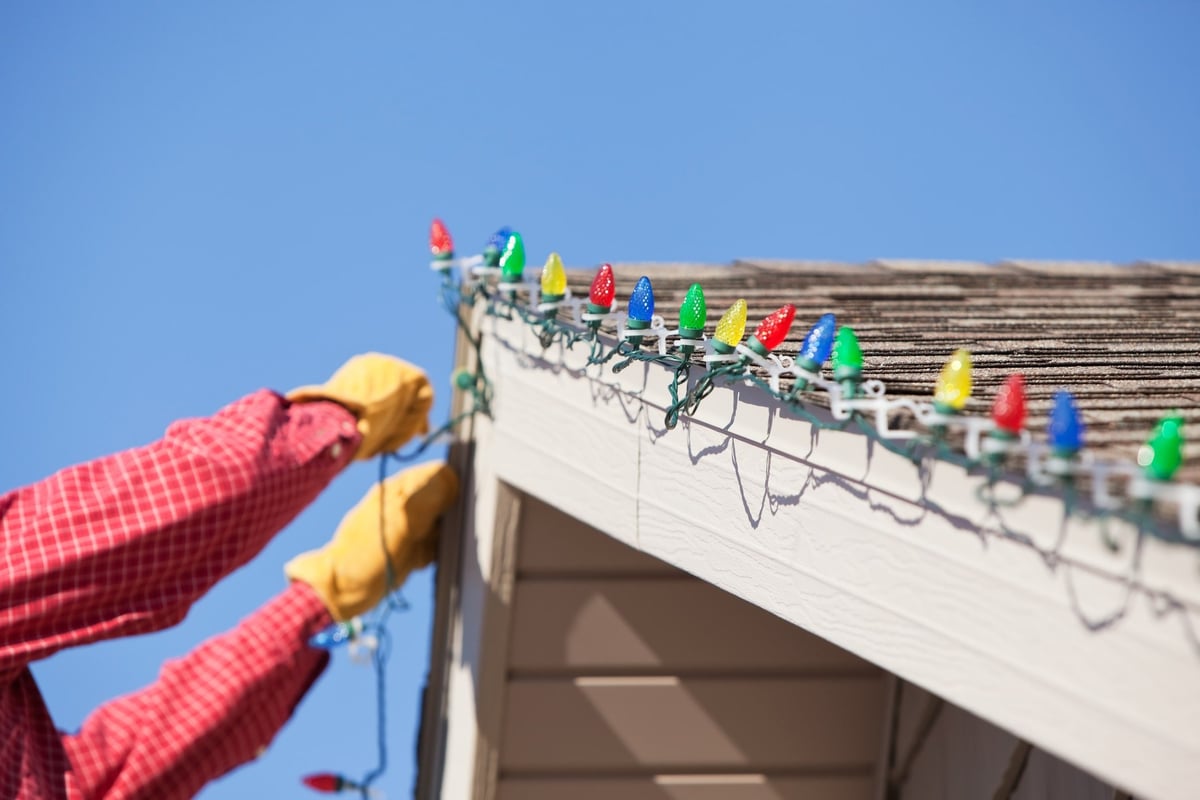How to start a Christmas light installation business
Holiday light installation can be a lucrative and rewarding business endeavor (if not one of the most promising winter business ideas). With an established, profitable Christmas light business, you could literally deck the halls and spread holiday cheer throughout your neighborhood and beyond.
If you’re thinking of starting your own business designing and hanging holiday lights, keep reading to learn all the details about how to start a Christmas light business.
#1 Create a business plan
When you’re starting a new business, laying out a clear, actionable plan will help you visualize your goals and what you need to do to achieve them. There are a few important things to consider when you’re setting those goals and crunching the numbers.
Define your specific service offering
Your holiday and Christmas light installation business can’t do it all—but it can do a lot. Here are some questions to ask yourself as you narrow down your plan:
- Between designing, configuring power sources, and installing the lights themselves, which will you take on? How hands-on would you be with the professional Christmas light installation?
- Will you handle everything in-house, partner with a local designer, or only execute the precise vision of your client?
- Is hardware included or will the customer supply the lighting fixtures and other decor elements?
- Perhaps the most fun question of all: how elaborate will your creations be? Simple lights along the roof and around the windows or stunning, towering animatronic displays?
- Holiday lights aren’t just for Christmas, either. Discover creative ways to cater to those in your neighborhood who want to decorate for holidays like Hanukkah, Kwanza, or even just the winter season.
Set reasonable goals for your first season in business, and don’t be afraid to start small and grow organically. According to Inc., companies that scale up too fast tend to lose track of foundational business details like solid financial reporting and modeling, core operational efficiencies, and deliberate hiring. If your Christmas lights installation business scales faster than you can scale your workforce, customer service, and tech suite, you may struggle to catch up.
Acquaint yourself with your ideal customer
Examine your local area and market to figure out who, exactly, you’ll be targeting with your sales and marketing efforts. In the same way that you want to start small with your business, consider doing the same with your audience: identify a niche that you can speak to directly and serve effectively. Limiting your scope means you can offer a more specialized service in a less competitive market, thereby building company loyalty within a small but solid customer base.
Focus your service options
There are several broad categories of holiday light installation to choose from as you begin to narrow your focus, find your customers, and finalize your business plan:
- Residential lighting installation – If you focus on residential services while you’re starting out, you’ll be targeting homeowners directly. There’s plenty of opportunity within the residential market, including affluent neighborhoods, particularly festive areas that tend to create displays for the whole city to enjoy, and homeowners who throw lavish parties and want exterior decor to match.
- Commercial lighting installation – If you have a thriving main street in your region with retail shops and storefronts, focusing on commercial lighting installation could be a profitable option as well. The holidays are the busiest time for retail shops and many choose to go all out to encourage customers to patronize their business over their competition. A cheery window display could be just the thing to bring in a swathe of new customers.
Additionally, you can also offer Christmas light removal to customers mindful of their safety when removing holiday decorations
Some companies, like Long Island Christmas Light Installation, tackle residential and commercial projects—and beyond—but it can take time to build up a business like that.
Season-extending revenue streams – The Christmas light installation industry has the most work from November through January, but there are ways you can extend your business offerings—and profitability—by providing year-round services. St. Nick’s is a California-based Christmas lighting and decor company, but they have an entire “Beyond Christmas” section on the website, which includes popular off-season ideas like:- Celebrations
- Permanent lighting
- Valentine’s day
- Halloween
- Pride
- Fall
- Spring
- Summer
Consider the competition as you pinpoint your niche
Before you jump in, you’ll want to take a look at other businesses offering similar services. If there’s a saturated market, that’s all the more reason to adjust your business model and focus on an underserved area. Within the holiday lighting industry, you might find companies that target more niche areas like:
- Businesses with large properties and lots of outdoor space to fill
- Affluent neighborhoods who want to set up elaborate light shows
- Individuals who want themed holiday lights based on famous holiday movies or themes
- Neighbors who have decorations but can no longer install them on their own
Create a detailed pricing model
So, how much to install Christmas lights? Compare similar services in your market area, or in a neighboring area if there isn’t local competition. Over-pricing can drive customers to a competitor, while underpricing can limit your earning potential or call the value of your services into question. If you’re in need of pricing guidance, our Christmas Light Pricing Guide can help you determine your ideal rates.
#2 Formalize your business and prepare for launch
Now that you have a vision laid out for your holiday light business, the next step is to set yourself up to legally do business in your state including incorporation, collecting and paying taxes, and configuring and utilizing billing and payment methods.
Incorporate your business
Depending on if you’re working solo, with a partner or two, or hiring a team of employees, you’ll need to decide how you want to operate. If you have questions about the best way to set up your business to fit your needs and company vision, it’s a good idea to consult with a professional so you don’t have to change your business structure later. Many regions have small business incubators that will offer free or low-cost assistance.
Understand your tax liabilities
Find out when and how you’ll need to be collecting and paying sales tax, as well as what you’ll need on hand for filing your annual income tax as a business entity. Get familiar with federal, state, and local tax laws. At the very least, apply for an EIN so you can file small business taxes with your state.
Know your startup costs
Finances are part of any comprehensive business plan, but it’s important to know exactly what your upfront costs will be as you embark on your new venture. Before you start hanging holiday lights all over town, keep in mind what you’ll need to invest in prior to booking your first client. Depending on the details of your business plan, you might need:
- Incorporation and filing fees
- Liability insurance
- Marketing costs including website, email, advertisements, and business cards
- Inventory, including strings of lights and other specialty decors
- Installation tools like ladders, light clips, and potential safety equipment
- Portable generators to power any large-scale setups
- Transportation for both your crew and supplies
- Storage unit rental
Open a business bank account and line of credit
Opening a business bank account will help you to keep your finances in one place, and a business line of credit will be useful if you need to make large inventory purchases if you don't have enough cash on hand to complete a large job.
Consider licensing, training, and certifications
When you’re just getting started with your light installation business, you’ll want to make sure you have the right knowledge to do the job properly and safely. If you’re already a light-hanging expert, you may still want to brush up on tips and techniques to keep you at the top of your trade.
Having official certifications will make you stand out as an expert to potential clients. Consider joining an organization like the Christmas Light Installation Professionals Association (CLIPA) to stay up to date on current industry trends. If you’ll be rigging specialty lights, creating high-voltage, power-intensive displays, or altering the property’s existing wiring, you may need a master or special electrician license from your state or city.
Set up invoicing and payments
You’ll need to establish a way (or ways) for your customers to pay you for their twinkling light displays. If you plan to accept credit card payments, you’ll need to enroll with a service like Stripe or Square. Digital payment services like PayPal and Venmo also offer invoicing capabilities for business accounts. Plan for business service fees on each transaction when you’re creating your pricing model and business plan.
#3 Promote your services
Now that you have everything in place to spread festive cheer through your neighborhood and beyond, it’s time to spread the word first:
- Leverage social media – Establishing a social media presence can help you interact directly with prospective clients, network with collaborators, and maintain control over your brand identity.
- Rely on word of mouth – Recommendations from trusted friends are often the best way to garner new clients. One happy client will open multiple doors to new ones. Aside from providing excellent service, a referral program is a great way to incentivize sharing with friends or posting reviews online.
- Paid advertising – Whether you pursue print, digital, radio, or all of the above, paid advertising can help you reach a large number of people in a short amount of time.
To build trust, build a portfolio
One of the best ways to show your capabilities and garner new customers is to have examples of your work. Before you land your first customer, you can do a trial installation on your own residence or that of a friend or family member. Christmas and holiday lighting is a visual art form, so the best way to encourage new customers is to show them what you’re capable of when it comes to your Christmas light business.
If you’re looking for inspiration, The Christmas Guys™ have a diverse portfolio of past projects on their website, from large-scale exterior displays to tasteful, detailed front entryways.
If you’re not a pro at photography or videography, enlist someone who is to capture the lighting display in an attractive way. Having a quality portfolio of visual content to share on your website, social media channels, and more will give your business a beneficial boost.
Light up your neighborhood with the help of Nextdoor
Starting a new business is an exciting opportunity, but you’ll need the right tools and knowledge to dive into the holiday light industry headfirst.
When you’re ready to spread bright and colorful holiday cheer with your Christmas light installation business, let Nextdoor help you find and expand your customer base. Claim your free Business Page, build relationships with current customers, connect with new ones, and get the word out. Turn to Nextdoor to make this brighter holiday season for your new business.
Sources:
Inc. 8 Dangers of Growing Your Business Too Fast. https://www.inc.com/cox-business/eight-dangers-of-growing-your-business-too-fast.html
CLIPA. Is Your Christmas Light Installer Certified? https://clipawebsite.com/is-your-christmas-light-installer-certified/
IRS. Business Taxes. https://www.irs.gov/businesses/small-businesses-self-employed/business-taxes
U.S. Small Business Association. Write Your Business Plan. https://www.sba.gov/business-guide/plan-your-business/write-your-business-plan






-1%20(1).jpg?width=200&name=iStock-1140598547%20(1)-1%20(1).jpg)
.jpg?width=200&name=NextdoorOakland-134-min%20(1).jpg)
.jpg?width=200&name=iStock-1160229044-min%20(1).jpg)
